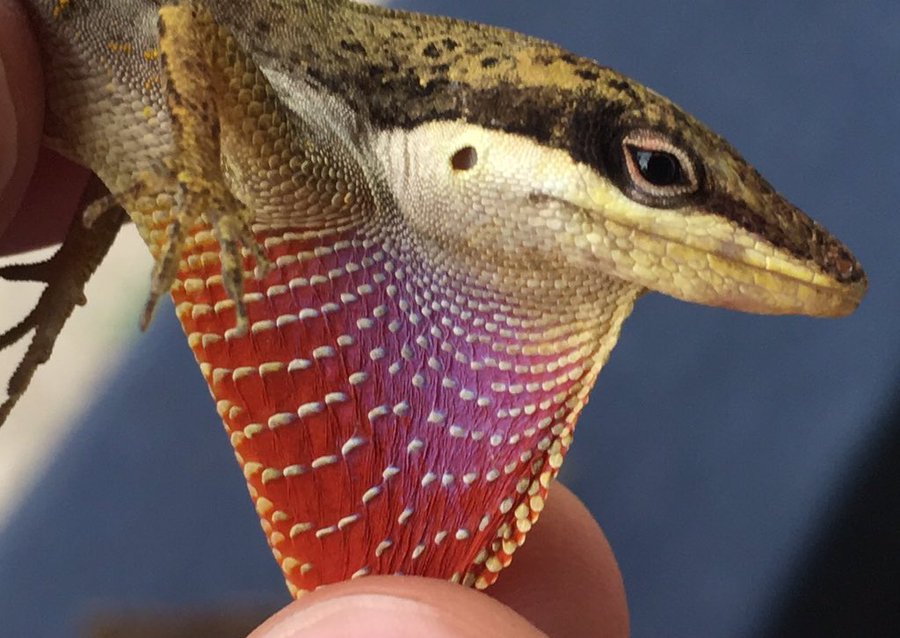In the most recent issue of Herp Review, Anole Annals stalwarts Kevin de Queiroz and Jonathan Losos documented their account of observing an adult female grass-bush anole (Anolis pulchellus) consume a dwarf gecko (Sphaerodactylus macrolepis) on Guana Island, British Virgin Islands. The authors share their detailed report below:
Many primarily insectivorous lizards will eat other vertebrates on occasion, a behavior that has been reported in many species of Anolis. One unifying generality is that such carnivory is size structured, with the predator usually being substantially larger than the prey (Gerber 1999. In Losos and Leal [eds.], Anolis Newsletter V, pp. 28–39. Washington University, Saint Louis, Missouri). Not surprisingly, reports of anole carnivory pertain primarily to middle-sized and larger anoles. Here we report carnivory by a small anole of the species A. pulchellus. To our knowledge, this is the first instance of carnivory reported for this species and one of few for any similar-sized anole (the record noted by Henderson and Powell 2009. Natural History of West Indian Reptiles and Amphibians. University Press of Florida, Gainesville, Florida. 495 pp. is based on the observations reported here).

Fig. 1. Female Anolis pulchellus in the process of ingesting a
Sphaerodactylus macrolepis.
We observed a female A. pulchellus (SVL ca. 38 mm) capture and consume a Sphaerodactylus macrolepis (SVL ca.18 mm) in the leaf litter at approximately 1430 h on 25 September 2006, on Guana Island, British Virgin Islands, near the head of the Liao Wei Ping Trail at roughly 18.47916°N, 64.57444°W (WGS 84). The anole jumped from a low perch (ca. 20 cm above the ground) to the ground and bit the gecko, which escaped and fled 15–20 cm to the opening of an ant nest. The anole attacked the gecko again, seized it in its mouth and carried it approximately 10 cm up a vine, a distance of 15–20 cm from the site of attack. Initially, the anole held the gecko upside down (i.e., dorsal surface facing down), biting it between the fore and hind limbs on the left side. Eventually the anole worked its grasp posterior to the base of the tail, still on the left side. At this point, parts of both the base of the tail and the left hind limb were in the anole’s mouth (Fig. 1). The anole then manipulated the gecko so that it was no longer upside down, but rotated about its long axis by roughly 90 degrees (the ventral surface of the gecko was then oriented forward relative to the anole) at which point it was biting the gecko at the base of the tail and possibly by the left hind limb; the anole eventually manipulated the gecko so that it held it tail-first in its mouth, dorsal side up, at which point the anole proceeded to ingest the gecko tail first (during this time, the tail itself broke off and was carried away by ants, which had been biting the gecko in several places since shortly after it was
captured by the anole). Total time from capture to complete ingestion was approximately five minutes.
Predation on Sphaerodactylus geckos has been reported in anoles of only a few species, none of which are as small as Anolis pulchellus (Henderson and Powell 2009. Natural History of West Indian Reptiles and Amphibians. University Press of Florida, Gainesville, Florida. 495 pp.). However, given the size discrepancy between the lizards in these two clades and their extensive coexistence across the Caribbean, we suspect that such interactions may occur with some frequency. Moreover, the high population densities of some Sphaerodactylus geckos (e.g., Rodda et al. 2001. J. Trop. Ecol. 17:331–338) and the diurnal activity of several species (Allen and Powell 2014. Herpetol. Conserv. Biol. 9:590–600) suggest that they may be important prey items for anoles.
References
– Allen, K.E. and Powell, R., 2014. Thermal biology and microhabitat use in Puerto Rican eyespot geckos (Sphaerodactylus macrolepis macrolepis). Herpetological Conservation and Biology, 9(3), pp.590-600.
– Gerber 1999. In Losos and Leal [eds.], Anolis Newsletter V, pp. 28–39. Washington University, Saint Louis, Missouri
– Henderson and Powell 2009. Natural History of West Indian Reptiles and Amphibians. University Press of Florida, Gainesville, Florida. 495 pp.
– Rodda, G.H., Perry, G.A.D., Rondeau, R.J. and Lazell, J., 2001. The densest terrestrial vertebrate. Journal of Tropical Ecology, 17(02), pp.331-338.































